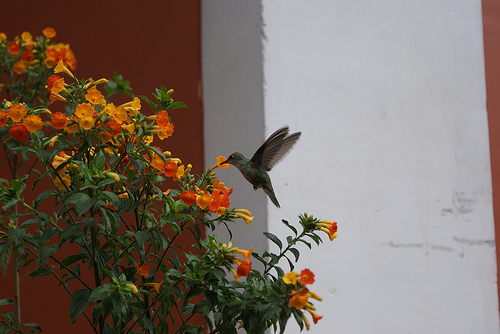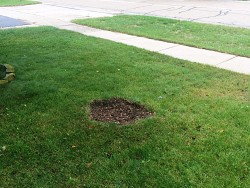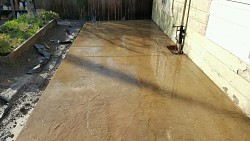Attracting Hummingbirds and Butterflies to Your Garden
 Attracting hummingbirds and butterflies to your garden not only brings a sense of delight, but ties you into something greater as well. “You can enjoy the full circle in your garden. Our plants are part of a global eco-system,” comments Sarah Mary Gerchman, assistant manager of Annie’s Garden and Gift Center in Amherst, MA.
Attracting hummingbirds and butterflies to your garden not only brings a sense of delight, but ties you into something greater as well. “You can enjoy the full circle in your garden. Our plants are part of a global eco-system,” comments Sarah Mary Gerchman, assistant manager of Annie’s Garden and Gift Center in Amherst, MA.
Gerchman gives the example of how hummingbirds eat aphids: “Aphids are often seen as immediate pests in gardens. So you can enjoy beautiful flowers, and attract hummingbirds which help protect the plants.” An additional note on garden pest control -- at a Vegetable Entomologist Workshop in Dallas, pest control experts cautioned to "avoid broad-spectrum insecticides to conserve natural enemies" like hummingbirds.
Flowers and tips to attract hummingbirds to your garden
Gerchman explains that hummingbirds are attracted to tubular-shaped flowers. For colder climates such as New England, one of the best choices is Trumpet Vine, as hummers are attracted to both the shape and bright red color. “What a lot of people don’t know is that hummingbirds don’t have a sense of smell. People think they are attracted to flowers with a strong fragrance. They are actually attracted to the colors - bright reds, pinks, and oranges.”
Gerchman describes Mandevilla plant as a good choice for warmer, more tropical climates, though it can be grown anywhere if it's brought inside for the winter. “They are a big draw for hummingbirds because the flowers are the perfect shape for their beaks. Also, if you have a big ugly fence you want to hide, Trumpet Vines are aggressive climbers. They have beautiful flowers and foliage,” she points out.
Gerchman adds that you can plan your hummingbird garden as perennial, or annual, and you can also incorporate shrubs. An added bonus of strategically planting shrubs is that they can help cut your summer HVAC costs by shading your house.
Recommended plants - hummingbirds
- Perennials: Aster, Bee Balm, Day Lily, Foxglove, Globe Thistle, Hollyhock, Lupine, Milkweed, and Phlox.
- Annuals: Cleome, Fuchsia, Impatiens, Petunia, Salvia, Snapdragon, and Zinnia.
- Vines: Honeysuckle, Morning Glory, and Scarlet Runner Bean.
- Shrubs: Butterfly Bush and Weigela.
If you put out hummingbird feeders, be sure to clean them at least once a month with a solution of ¼ C. bleach or white vinegar to one gallon of water. Avoid using soap as the birds do not like the taste. Annie’s literature also recommends adding a running water feature to your garden to attract hummingbirds as this creates a comfortable habitat for them.
Attracting butterflies to your garden
To attract butterflies, Gerchman suggests incorporating shallow pools in your gardens so they have water to drink. “Some people take the tops of bird baths and sink them into the garden.” (Be careful that these pools do not become mosquito habitats.) According to Gerchman, butterflies like bright, sunny areas. “Butterflies need to maintain their body temperatures between 85 and 100 degrees. That’s why you often see them resting on a flat rock. So incorporating flat rocks into your garden gives them a place to sit and warm up.”
As for plants, Gerchman mentions that the “classic” choice is Butterfly Bush. “When we get a shipment in here, sometimes there are clouds of butterflies attracted to them.” (NOTE: Butterfly Bush can be invasive under certain growing conditions. Find out more from your local university extension service.) Another choice is Butterfly Weed, which when growing wild is also known by the less attractive name, Pleurisy Root.
Female butterflies locate and lay eggs on plants that provide food for caterpillars such as Dill, Holly Hock, Milkweed, and Sunflowers.
Recommended plants - butterflies
- Perennials: Many of the same flowers that attract hummingbirds, as well as Black Eyed Susan, Cone Flower, Joe Pye Weed, Lavender, and Turtlehead.
- Annuals: Lantana, Marigold, Nasturtium, and Sunflowers.
- Shrubs: Blueberry bushes and Lilac.
Work with a savvy landscaper and custom-design your garden to attract hummingbirds and butterflies.
Cris Carl writes for networx.com.
Updated May 10, 2018.
Updated May 10, 2018.
Looking for a Pro? Call us (866) 441-6648

Landscaping Average Costs
Landscapers Experiences

The Right Landscaper Can Change A Yard From Terrible To Terrific

Tree Removal So Fast And Efficient It Didn’t Even Wake Our Newborn



